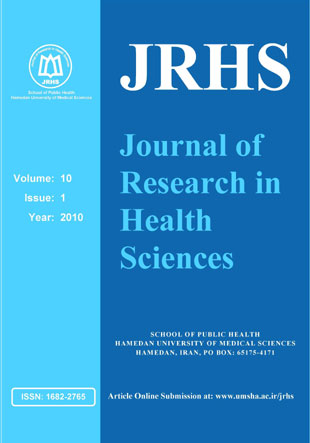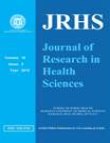فهرست مطالب

Journal of Research in Health Sciences
Volume:10 Issue: 1, Winter-Spring 2010
- تاریخ انتشار: 1389/04/06
- تعداد عناوین: 8
-
-
Page 7BackgroundMost of the studies have reported higher occupational health haz-ards on hazardous waste workers (HWW). However reports regarding the asso-ciation between health hazards and pro-inflammatory cytokines in HWW are scanty. The present study was undertaken to evaluate the relationship between occupational health hazards and serum pro-inflammatory cytokines in HWW.MethodsOne hundred two subjects working in hazardous waste areas in differ ent parts of Bangalore at Karnataka, India were enrolled into the study in 2009. Using questionnaire the respiratory morbidity and other work related problems in HWW was carried. The levels of pro-inflammatory cytokines in study subjects were determined by using Enzyme-linked-immunosorbent assay kits (Pierce Biotechnology, USA). The differences of serum pro-inflammatory cytokines levels between the groups were computed by using non-parametric Mann-Whitney U test. SPSS 10.0 for windows version of statistical software was used in the analy sis.ResultsThe morbidity conditions such as respiratory (34%), musculo-skeletal (24.5%), past illnesses (12.7%), dermatological (11.8%), gastrointestinal (9.8%), injuries due to contact with sharp objects & heavy equipments (7.8%) and nose and eye (4.9%) problems were observed in HWW. The levels of serum pro-in flammatory cytokines such as IL-8 (P=0.041) & TNF-α (P=0.040) significantly increased in landfill area workers and subjects having respiratory symptoms.ConclusionThe levels of serum pro-inflammatory cytokines IL-8 & TNF- α were sig nificantly associated with subjects having respiratory symptoms & further support ing that they are inflammatory markers in respiratory symptoms.
-
Page 15BackgroundThe novel influenza A (H1N1) virus was first detected in March 2009 in Mexico and then disseminated to many other countries worldwide. In this study, we assessed the potential risk factors of swine flu as well as the most important clinical manifestations of this infectious disease among confirmed cases during early phase of pandemic H1N1.MethodsSubjects (cases and controls) were selected from those patients with signs and symptoms of respiratory tract infection who referred to health centers of eight cities throughout Hamedan Province, western Iran form July to December 2009. Characteristics of the participants were obtained by interviewers using pre-determined questionnaire. Cases were distinguished by pharyngeal soap speci-mens positive for influenza A virus using polymerase chain reaction (PCR). Logistic regression model was conducted at 0.05 significance level using Stata 9.1 statistical software to assess the effects of various risk factors on H1N1 influenza infection.ResultsTotally, 245 confirmed cases of H1N1 influenza were compared with 388 controls. Case fatality rate of influenza infection was about 2.86%. In comparison with age group of 1-19 yr old, adjusted odds ratio estimates was 1.91 [95% CI: 1.06, 3.46] for age group of 20-39 yr old, 0.94 [0.37, 2.38] for age group of 40-59 yr old, and 0.34 [0.09, 1.37] for age group of 60-79 yr old. Adjusted odds ratio estimates of influenza A infection was 8.12 [95% CI: 3.11, 21.6] for pregnant women compared to non-pregnant women; 1.84 [95% CI: 1.32, 2.86] for high educated individuals in comparison with low educated individuals; 2.11 [95% CI: 1.25, 3.57] for whose who had close contact with suspected influenza patients; and 2.15 [95% CI: 1.16, 3.98] for individuals with normal body mass index (BMI= 25-30) compared with underweight individuals (BMI< 20). There were no significant differences in clinical manifestations between cases and controls.ConclusionThe risk of influenza A infection is highest among children and adolescents, pregnant women, high educated individuals, and those who had close contact with suspected influenza patients during pandemic phase. In addition, there is no pathogonomonic sign or symptom to distinguish influenza infection clinically from other kinds of respiratory track infections.
-
Page 22BackgroundThe adverse effects of noise are well known and noise problems due to industrialization of communities are increasing over the time. Oil industries due to the process and nature of production; contain many noise sources such as compressors, turbines, and pumps, which cause excessive noise exposure. The objective of this study was to evaluate the noise characteristics of compressors in Tehran Oil Refinery and study on visible control measures.MethodsTo get to the appropriate control method, procedures such as basic theories, measuring sound parameters, frequency analysis, related diagrams and noise propagation schemes due to the measurement results, equivalent noise exposure level (Leq(8h)) and exposure noise dose and technical specification of compressors are considered in this paper. Considering field and analytical re sults, module enclosure with particular specifications (like absorbent layer, specific wall, window and door design etc.) is predicted to be the best control method.ResultsCalculation results of multiple layer density of the enclosure (W = 16.5 kg/m2) and needed density for the dominant frequency of the source (W = 12 kg/m2) demonstrated that the designed enclosure satisfies the goal.ConclusionResults of designing sandwich layers’ module demonstrated that install ing the designed enclosure causes 20 dB(A) reduction in total sound pres sure level of the source’s dominant frequency.
-
Page 31BackgroundTrichomoniasis is recognized as a major sexually transmitted dis-ease (STD) in the world and has the highest prevalence and incidence of STD. the prevalence strongly is related to cultural and social norms in different socie-ties, in relation to sexual partnership, monogamy, or polygamy. Our objective was to describe the frequency and natural history of infection and correlation of clini cal signs with parasite detection.MethodsFrom February 2006 to March 2007, in a cross sectional study, clinical and wet mount examination of vaginal smear along with culture were performed on 683 women attending to private outpatient clinics in Hamadan, western Iran. Trichomoniasis was diagnosed based on major clinical symptoms. Diagnosis was con firmed using wet mount microscopically and culture in Diamond medium.ResultsOnly 2.2% of patients with clinically diagnosed trichomonal vaginitis were positive for Trichomonas vaginalis by wet smear and culture. The mean age of patients was 33.6±9.7 yr, and majority of them were married and non-pregnant. Some (5 patients) infected cases were divorced and others (7 patients) hus band were car driver. There was not statistically significant relationship be tween clinical diagnosis and laboratory findings (P>0.5), because the most of pa tients diagnosed trichomoniasis, were infected by Candida or other vaginal infec tions.ConclusionBecause of special cultural background, the vaginal trichomoniasis has minor importance problem in this population and clinical diagnosis is not effi cient for treatment decision.
-
Page 36BackgroundThis study aimed to evaluate the design of emergency depart-ments regarding to the patients’ and staff''s privacy, confidentiality and facilities in gen eral teaching hospitals.MethodsEmergency departments of all the general teaching hospitals of Shahid Be heshti University of Medical Sciences, Tehran, Iran were evaluated in 2007 through both direct observation and interview with hospital authorities, and staff. Rele vant criteria were studied by a 27-item questionnaire including 19 items for facili ties and 7 items for privacy and confidentiality. Extent of emergency depart ments was the last common criterion. Data analysis has been done using t-test and descriptive statistics when appropriate. SPSS Software version 16 was used to facilitate quantitative analysis.ResultsEleven out of nineteen criteria (58%) for the facilities were not found in the emergency departments. Privacy criteria had an overall partially more accept able situation. Only one criterion of privacy and confidentiality was negative for all the emergency departments. It was calm gynecologic and delivery room with spe cific toilet. The mean was 469.6 (SD= 96) square meters for existing extent of emer gency departments and 1461.6 (SD= 262.1) square meters for the ideal val ues (P< 0.01).ConclusionPrivacy, confidentiality and enough facilities should be considered in designing of teaching hospitals for both stuff and patients. Most of them need to be reconstructed based on new national standards.
-
Pages 42-46BackgroundThis study aimed at determining the job satisfaction level of the staff in Shahroud University of Medical Sciences (SUMS), northern Iran, and its influential factors.MethodsIn this descriptive study, conducted in 2008, the participants were 384 workers in SUMS selected through simple random sampling procedure. The par ticipants received a 33-item questionnaire in a Likert format (8 general items and 25 items related to job satisfaction facets). The collected data in form of frequen cies and percentages were analyzed with SPSS software.Results53.4% of interviewees were female and more than 60% had associate or higher degrees. 42.6% had less than 10 yr and 30.9% had 20 to 30 yr of job experience, respectively. The mean of the overall satisfaction was 13.02 out of 20. Regarding the facets of job satisfaction, work, coworkers, supervisor, and pro motion had the highest means, respectively. Pearson and Spearman correla tion coefficients showed a significant relationship between overall satisfaction and the facets (P= 0.001). Analysis of variance also showed significant difference in overall satisfaction based on organizational units; however, no significant rela tionship was observed between overall satisfaction and gender, degree, age, job experience and type of employment.ConclusionImprovement of promotion process, training and qualifying manag ers, observing meritocracy principles in appointments, using cooperative man agement, creating convivial and friendly atmosphere and improving work envi ronment conditions, have brought about an increase in overall satisfaction of em ployees in SUMS
-
Page 47BackgroundUsers of hospital information system (HIS) use these systems dur ing working day and know its problems better than oth ers know. Studying their views is very important and can be espe cially effective in the development of the in formation system. The aim of this study was to investigate the users'' views to wards the qual ity of hospital information system in the training hospitals of Mash had University of medical sciences.MethodsThe current study was an applied research in Training Hos pitals of Mash had (East of Iran), which was conducted with de scriptive cross-sectional method. A four-section questionnaire was de signed for data collection consisting of: characteristics of informa tion quality, reasons of low quality of information, accessi bility of infor mation and decision support. Validity and reliability were tested and SPSS was used for data analysis.Results62.8% of users explained that one of reasons of low qual ity information was a problem related to obtaining information. 47.7% of them were unsatisfied with hospital information system abil ity for decision-making support. In general, 53.2% of users were slightly satisfied with the overall quality information of the sys tem.ConclusionThere are some problems concerning information qual ity of HIS in Mashhad training hospitals. These problems in clude inappropriate information qual ity of the system and incom patibility with user needs which leads to de-creased satisfaction of us ers towards the system.
-
Page 54BackgroundNosocomial infections constitute a global health problem, leading to a high rate of morbidity and mortality. The aim of this study was to determine the frequency and antimicrobial resistance patterns of nosocomial infections in edu cational hospitals of Hamadan, western Iran.MethodsDuring a 1-year period from April 2006 to March 2007, all patients with cul ture-proven nosocomial infections from educational hospitals in Hamedan, west ern Iran were included. Nosocomial infections were defined as a culture-proven infection, which occurred more than 48h after admission in the hospital. An timicrobial susceptibility testing of isolated bacteria was performed by disc dif fusion method.ResultsA total of 170 cases of culture-proven nosocomial infections were diag nosed. Most cases were in intensive care units (ICUs) (57.4%). The common sites of infection were lower respiratory tract (51.8%) and urinary tract (31.9%). Kleb siella pneumoniae, Pseudomonas aeruginosa, and Escherichia coli, were the most prevalent pathogens (32.7%, 22.9%, and 14.8% respectively). Most en terobacteriacea isolates were resistant to third generation cephalosporins. The resis tant rates to ceftriaxone were 75.5% for K. pneumoniae, and 76% for E. coli. Among P. aeruginosa isolates, 26.5% were resistant to ceftazidim, and 36% to cipro floxacin. Among S. aureus isolates, 80% were methicillin-resistant.ConclusionThe patients in the ICUs are at a higher risk of nosocomial infec-tions. The high prevalence of antimicrobial resistance in the hospitals highlights the need of further infection control activities and surveillance programs.


